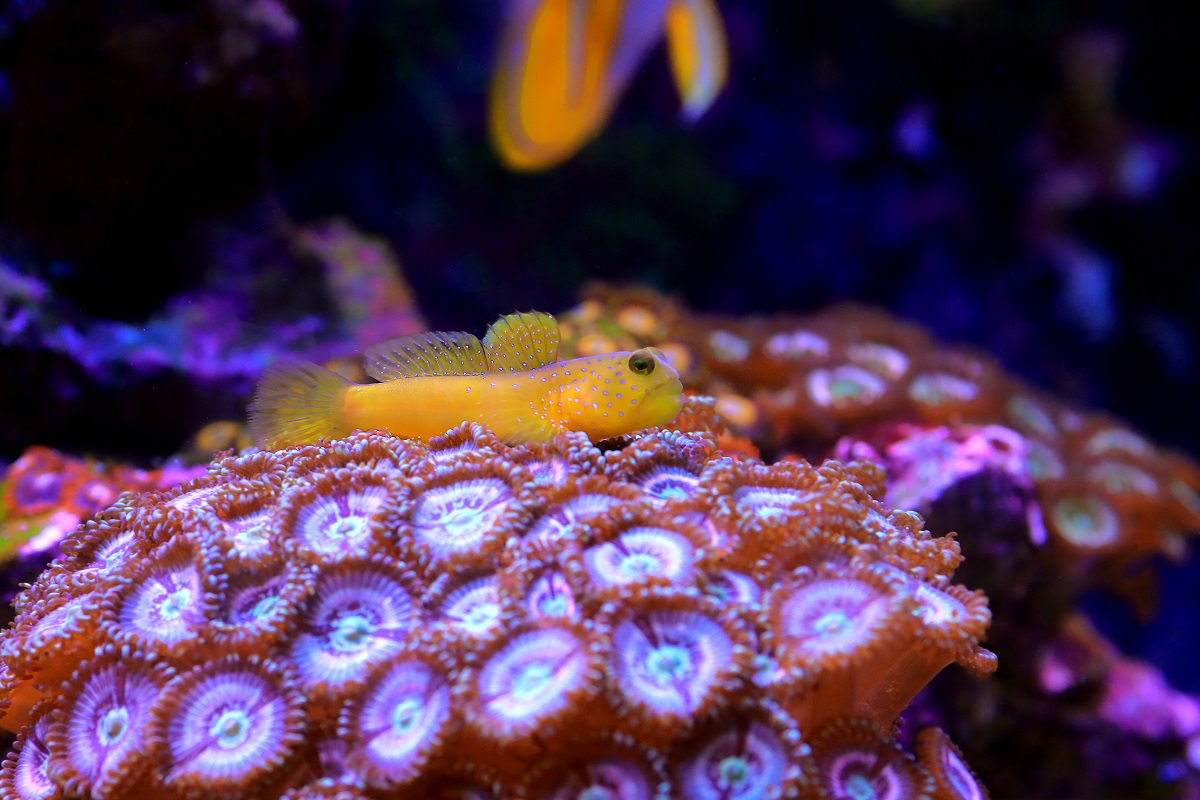The bright yellow watchman goby, also known as yellow prawn goby, is a fascinating saltwater aquarium fish. It’s suitable for beginning marine aquarists, does well in smaller aquariums and its bright coloration makes it a cheerful addition to your tank.
Keep reading for everything you need to know about yellow watchman goby care and keeping these gobies in your home aquarium!
MINI QUIZ: Which nearly blind invertebrate species does the yellow watchman goby maintain a symbiotic relationship with?
| Name (Common, Scientific) | Yellow watchman goby, Cryptocentrus cinctus |
| Minimum tank size | 20 gallons |
| Minimum group size | 1 |
| Temperature | 72-82 °F |
| Salinity | 1.020-1.025 |
| pH | 8.0-8.4 |
| Difficulty level | Easy |
Yellow watchman goby description & natural habitat
Description
The yellow watchman goby, as its name suggests, is a bright yellow, bottom-dwelling goby species.
The species can grow to up to around 4” in length and sports frog-like eyes, a broad mouth and neon blue flecks across the front of its body.
Natural habitat
Naturally found in the eastern Indian Ocean and the western Pacific, from India to New Caledonia (past Australia), this species calls the shallow reef its home. It’s a well-known inhabitant of the iconic Great Barrier reef.
The yellow watchman goby is found at depths of up to 82 ft, usually sticking to the sandy seabeds in lagoons.
Did you know? Although large amounts of yellow watchman gobies are taken from the wild for the aquarium hobby each year, they’re considered a species of Least Concern by the IUCN. Still, we hope that one day soon, all of the ones available in local aquarium stores will be captive bred!
Yellow watchman goby aquarium
Because yellow watchman gobies are so small, they don’t need a large tank to thrive. A 20 gallon set-up should probably be enough for a single watchman; if you’d like to keep a mated pair, you could consider a 30 gallon.
This species is a bottom dweller and inhabits burrows, which means an aquarium with a sandy substrate is preferable. Make sure there’s a mix of hiding places as well as open spots available, as your watchman will appreciate being able to wait out in the open for food but dart away at the slightest sign of danger.
Note: your aquarium should have a tight-fitting lit. Yellow watchman gobies and other goby species are known to jump out of their tanks.
Yellow watchman goby compatibility
Yellow watchman goby and pistol shrimp
Did you already know the answer to the quiz question at the start of this article? Part of what makes the yellow watchman goby such a fascinating aquarium fish is the symbiotic relationship it forms with alpheid shrimp species. In the aquarium world, these are better known as pistol shrimp.
Although pistol shrimp (also known as snapping shrimp) carry a pretty formidable punch, their eyesight is extremely limited. That’s where the yellow watchman goby comes in, and where it gets its common name from! This highly vigilant fish keeps an eye out for the both of them, thereby ensuring the pistol shrimp’s safety. If danger occurs, the alarm is communicated to the shrimp by means of touch.
The shrimp will also get to scoop up any small scraps of food the goby drops. Whether the food comes from the front or the, ahem, back of the goby, doesn’t seem to matter. The shrimp have been observed to be quite bold about the rules of sharing, taking meals right out of their host’s mouth without any struggle.
So what does the yellow watchman goby get in return? A house! The pistol shrimp will dig out a burrow for the dream team to inhabit, making sure it’s in tip top shape at all times. Addititonally, the shrimp will also sometimes clean the goby of ectoparasites, ridding it of itchiness while catching a meal for itself at the same time.
In the aquarium, your yellow watchman goby doesn’t need to be accompanied by a pistol shrimp. However, it’s quite interesting to see the two of them in action, so we definitely recommend considering keeping them together.
Note: pistol shrimp can’t break aquarium glass like some sources suggest, although larger specimens can pose a threat to ornamental shrimp. Other than that, they’re considered reef safe.
Other
The yellow watchman goby is considered reef safe, making it a great option if you want to grow corals as well. Just keep in mind that although the species is generally peaceful, it becomes fiercely territorial when other gobies are involved. It’s best to stick to a single watchman or a mated pair to prevent brawls!
Yellow watchman goby diet
In the wild, the yellow watchman goby sifts the sand in search of algae and small meaty bits. This species is not picky when it comes to food, which is one of the reasons it’s such a great option for beginning aquarists. Marine fish flakes or sinking pellets should happily be accepted.
Aside from commercial aquarium fish foods, you can also offer (thawed) frozen foods like mysis and brine shrimp. Just make sure your yellow watchman goby actually gets its fair share: because it’s a bottom feeder and a bit timid, it might be outcompeted by more boisterous tankmates.
Breeding yellow watchman goby
Unlike many other marine fish, the yellow watchman gobby breeds in the aquarium. This is done on a commercial scale by ORA Farms, for example, but it should also be possible to get yours to reproduce at home. A happy and healthy pair of yellow watchman gobies will usually spawn without any efforts on your part. If you have some experience, you may be able to raise the fry.
The pairing up of yellow watchman gobies isn’t too challenging, as they can change their sex. Placing two individuals together will often eventually result in a couple, with the female (or the fish that changed to female) taking on a greyish hue. You can also try introducing a yellow-colored fish to a grey one.
To breed your gobies, it helps to move the pair into a dedicated breeding set-up (20 gallons, for example). Make sure there are plenty of caves and tubes available to help them feel safe and provide a place to spawn. Using loose décor pieces also allows you to easily pull the nest later in order to move it into a separate hatching tank (something like a 10-gallon, maybe not filled to the top at first).
As mentioned in Amy Drehmel’s brilliant yellow watchman breeding report, the eggs hatch after only 4 days. This immediately presents the biggest challenge in breeding these fish: their babies are so tiny! Much smaller than baby clownfish, for example. This means they need to be fed very, very tiny foods as well. Drehmels recommends s-rotifers, which only grow to 150 microns (that’s zero point fifteen millimeters).
Once the fry have grown, you can move to larger rotifers and then other small foods.
Conclusion
Whether small or large, a marine aquarium featuring a yellow watchman goby and its trusted pistol shrimp sidekick is a fascinating addition to your home or office. If you’re dreaming of your own reef, contact us here so we can design, build and maintain it for you.
Sources & further reading





